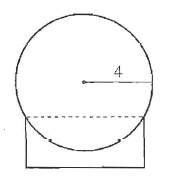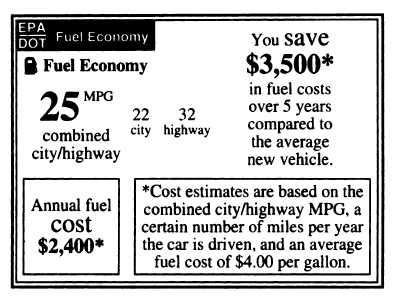(29.) A liquid substance has a density of $10$ pounds per gallon.
Convert this into grams per cubic centimeter using only the information:
$
1\:gal \approx 231\:inch^3 \\[3ex]
1\:lb \approx 453.6\:g \\[3ex]
1\:inch = 2.54\:cm \\[3ex]
$
Round your answer to the nearest hundredth as needed.
Per gallon means $1$ gallon
Per cubic centimeter means $1$ cubic centimeter
We are restricted to using only that information.
As you can see, we do not have any direct conversion from $gal$ to $cm^3$
So, we need to establish that conversion.
How?
We have the conversion from $inch$ to $cm$
We have the conversion from $gal$ to $inch^3$
We have to figure a way to do it. ☺
$
1\:inch = 2.54\:cm \\[3ex]
Cube\:\:both\:\:sides \\[3ex]
(1\:inch)^3 = (2.54\:cm)^3 \\[3ex]
1^3\:inch^3 = 2.54^3\:cm^3 \\[3ex]
1\:inch^3 = 16.387064\:cm^3 \\[3ex]
\underline{First\:\:Method:\:\:Unity\:\:Fraction\:\:Method} \\[3ex]
10\:lb/gal\:\:to\:\:g/cm^3 \\[3ex]
\dfrac{10\:lb}{1\:gal} * \dfrac{.....g}{.....lb} * \dfrac{.....gal}{.....inch^3} * \dfrac{.....inch^3}{.....cm^3} \\[5ex]
\dfrac{10\:lb}{1\:gal} * \dfrac{453.6\:g}{1\:lb} * \dfrac{1\:gal}{231\:inch^3} * \dfrac{1\:inch^3}{16.387064\:cm^3} \\[5ex]
= \dfrac{10 * 453.6}{231 * 16.387064} \\[5ex]
= \dfrac{4536}{3785.41178} \\[5ex]
= 1.19828443\:g/cm^3 \\[3ex]
\approx 1.20\:g/cm^3 \\[3ex]
$
$
\underline{Second\:\:Method:\:\:Proportional\:\:Reasoning\:\:Method} \\[3ex]
Let\:\:x\:\:be\:\:the\:\:converted\:\:unit\:\:in\:\:g\:\:for\:\:10\:lb \\[3ex]
$
Numerator
| $lb$ |
$g$ |
| $1$ |
$453.6$ |
| $10$ |
$x$ |
$
\dfrac{x}{10} = \dfrac{453.6}{1} \\[5ex]
Multiply\:\:both\:\:sides\:\:by\:\:10 \\[3ex]
10 * \dfrac{x}{10} = 10 * \dfrac{453.6}{1} \\[5ex]
x = 10(453.6) \\[3ex]
x = 4536\:g \\[3ex]
\underline{Third\:\:Method:\:\:Fast\:\:Proportional\:\:Reasoning\:\:Method} \\[3ex]
Let\:\:y\:\:be\:\:the\:\:converted\:\:unit\:\:in\:\:cm^3\:\:for\:\:1\:gal(231\:inch^3) \\[3ex]
$
Denominator
| $inch^3$ |
$gal$ |
$cm^3$ |
| $1$ |
|
$16.387064$ |
| $231$ |
$1$ |
$y$ |
$
\dfrac{y}{16.387064} = \dfrac{231}{1} \\[5ex]
Multiply\:\:both\:\:sides\:\:by\:\:16.387064 \\[3ex]
16 * \dfrac{y}{16.387064} = 16 * \dfrac{231}{1} \\[5ex]
y = 16(231) \\[3ex]
y = 3696\:cm^3 \\[3ex]
\underline{Entire\:\:Question} \\[3ex]
10\:lb/gal \\[3ex]
= \dfrac{x}{y} \\[5ex]
= \dfrac{4536}{3696} \\[5ex]
= 1.22727273\:g/cm^3...oops... \\[3ex]
$
Teacher: There is a problem here...
It is not the same exact value that we got using the Unity Fraction Method.
*Student: Why is that?...speaking like an American lol
*Teacher: Can you figure out why?...asking questions with questions...typical of a Nigerian lol
Student: Well, I think it is because we are working with rounded values (approximate values) rather
than exact values.
Teacher: That is correct.
So, what do we do to get the same answer as the First Method?
Student: Work with exact values. Do not work with approximate values.
Teacher: Okay.
But...specifically to this question, what should we use?
Student: I think we should convert $1\:inch^3$ to gallons first...
Then, we use the $gal$ to $cm^3$ measurement and find $y$
Teacher: That is correct!
$
Re-do \\[3ex]
\underline{Third\:\:Method:\:\:Fast\:\:Proportional\:\:Reasoning\:\:Method} \\[3ex]
Let\:\:c\:\:be\:\:the\:\:converted\:\:unit\:\:in\:\:gal\:\:for\:\:1\:inch^3 \\[3ex]
Let\:\:y\:\:be\:\:the\:\:converted\:\:unit\:\:in\:\:cm^3\:\:for\:\:1\:gal(231\:inch^3) \\[3ex]
$
Denominator
| $inch^3$ |
$gal$ |
$cm^3$ |
| $1$ |
$c$ |
$16.387064$ |
| $231$ |
$1$ |
$y$ |
$
\dfrac{c}{1} = \dfrac{1}{231} \\[5ex]
c = \dfrac{1}{231}\:gal \\[5ex]
Next \\[3ex]
\dfrac{y}{1} = \dfrac{16.387064}{c} \\[5ex]
y = 16.387064 \div c \\[3ex]
y = 16.387064 \div \dfrac{1}{231} \\[5ex]
y = 16.387064 * \dfrac{231}{1} \\[5ex]
y = 3785.41178\:cm^3 \\[3ex]
\underline{Entire\:\:Question} \\[3ex]
10\:lb/gal \\[3ex]
= \dfrac{x}{y} \\[5ex]
= \dfrac{4536}{3785.41178} \\[5ex]
= 1.19828443\:g/cm^3 \\[3ex]
\approx 1.20\:g/cm^3
$
 For ACT Students
For ACT Students 
